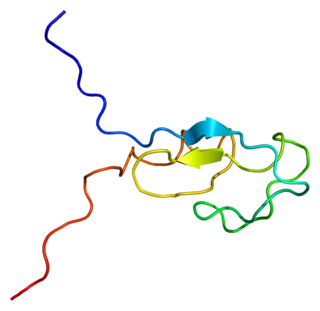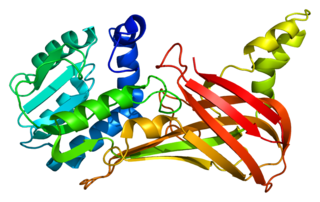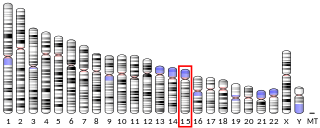
Trpc4-associated protein is a protein that in humans is encoded by the TRPC4AP gene.

Protein kinase C gamma type is an enzyme that in humans is encoded by the PRKCG gene.

Adhesion G-protein coupled receptor A3 (ADGRA3), also known as GPR125, is an adhesion GPCR that in humans is encoded by the Adgra3 gene.

PHD finger protein 20 is a protein that in humans is encoded by the PHF20 gene.

CCR4-NOT transcription complex subunit 6 is a protein that in humans is encoded by the CNOT6 gene.

Myosin-XVIIIb is a protein that in humans is encoded by the MYO18B gene.

Protein arginine N-methyltransferase 3 is an enzyme that in humans is encoded by the PRMT3 gene.

Sestrin 1, also known as p53-regulated protein PA26, is a protein that in humans is encoded by the SESN1 gene. This gene encodes a member of the sestrin family. Sestrins are induced by the p53 tumor suppressor protein and play a role in the cellular response to DNA damage and oxidative stress. The encoded protein mediates p53 inhibition of cell growth by activating AMP-activated protein kinase, which results in the inhibition of the mammalian target of rapamycin protein. The encoded protein also plays a critical role in antioxidant defense by regenerating overoxidized peroxiredoxins, and the expression of this gene is a potential marker for exposure to radiation. Alternatively spliced transcript variants encoding multiple isoforms have been observed for this gene.

Nei endonuclease VIII-like 3 is a protein in humans that is encoded by the NEIL3 gene.

Calpain-6 is a protein in humans that is encoded by the CAPN6 gene.

Poly (ADP-ribose) polymerase family, member 16 is a protein in humans that is encoded by the PARP16 gene.

SLX1 structure-specific endonuclease subunit homolog B is a protein in humans that is encoded by the SLX1B gene.

Poly(A) binding protein, cytoplasmic 4-like is a protein that in humans is encoded by the PABPC4L gene.

Lysine demethylase 8 is a protein that in humans is encoded by the KDM8 gene.

Left-right determination factor 2 is a protein that in humans is encoded by the LEFTY2 gene.

PAN3 poly(A) specific ribonuclease subunit is a protein that in humans is encoded by the PAN3 gene.

Radial spoke head 14 homolog is a protein that in humans is encoded by the RSPH14 gene.

HEPACAM family member 2 is a protein that in humans is encoded by the HEPACAM2 gene.

Poly(A) binding protein interacting protein 2B is a protein that in humans is encoded by the PAIP2B gene.

Poly(A) binding protein cytoplasmic 5 is a protein that in humans is encoded by the PABPC5 gene.
















